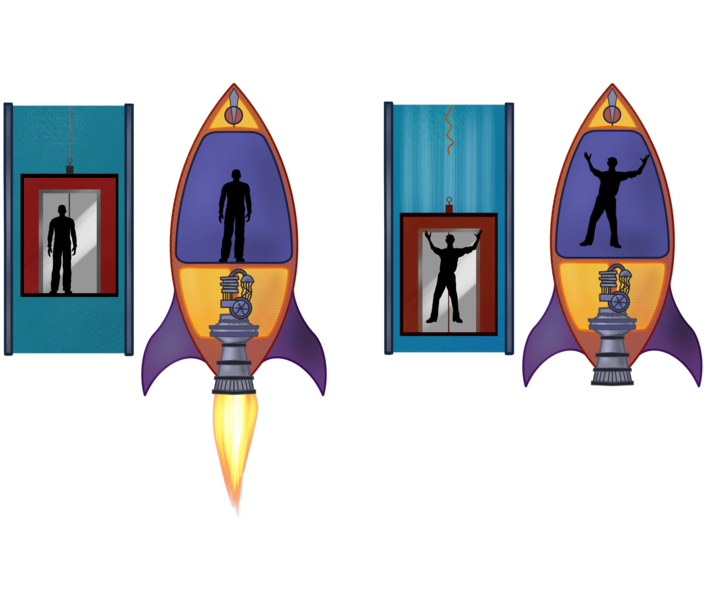This lesson needs to explain the header image, that is ALL it needs to do. The “inertial reference frames” title is a bit misleading. This is more of a lessons about the “equivalency principle” and how inertial mass and gravitational mass are indistinguishable as far as we know.
Our device has a sensor that measures acceleration, but we have to subtract 1g from the measurement to use it for most things. Explaining this would be a nice “stretch goal” for our lessons.
We do not need to talk about inertial forces and centripetal vs centrifugal, that would be way too advanced.
Suggested structure: - How do you know you are moving? By looking at things that you say are “stationary”. But there is some arbitrariness to what you call stationary. This example rely’s on sight, and seeing things pass by
#Outline
For this lesson, we’re going on a road trip, up an elevator, and on a rocket ship to explore what physicists call reference frames.
Road trip to lift off-site: Use a smooth rode to describe the idea of a reference frame and an inertial reference frame. Use a bumpy road or sudden stop to describe a non-inertial frame
Take an elevator up to the rocket ship: You have a box of supplies on a scale. Use this setting to describe part of the image.
Take the rocket ship far away, away from any gravity. Use this setting to finish describing the image.
_____________Draft Below_ For this lesson, we’re going on a road trip, up an elevator, and on a rocket ship to explore what physicists call reference frames. For an introduction to reference frames, imagine you’re riding down a smooth road in a car to the rocket lift off-site. Outside your window, you can see trees and park benches speed by. However, if you look beside you in the car, nothing has moved. All of your space gear is stationary in the seat next to you, and your favorite drink is in the cupholder. However, someone sitting on a park bench outside would have a different experience. To this observer, the trees around them and the park bench would be stationary, but the car and everything in it would whizz by. What is happening in this scenario? In physics terms, we would explain this by saying that the car and the park bench are in two different reference frames.
Assume your car is moving at a constant speed of 30 miles per hour, on a smooth, straight road. These two reference frames, the car, and the park bench are moving at constant speeds with respect to each other. Two reference frames moving at constant speeds to each other are called inertial reference frames.
(Insert picture of reference frames)
Add a box that the park bench is not “stationary” by every definition, as it is attached to Earth, which rotates and travels around the sun State that we won’t explore that any further in this lesson
Now, after your journey to the rocket launch site, you have to ride up a tall elevator with your space gear to enter the rocket. In this scenario, we will explore if an elevator is a separate reference frame. For an experiment you are performing in space, you have a scale. You’ve placed your gear on the scale for transport, and see that it weight 50 lbs before the elevator begins moving. The elevator begins moving at a steady rate, and you make it up 50 flights, when suddenly SNAP the cables break!! After the initial drop in your stomach, how would you know if the elevator was still falling? There are no windows in the elevator, so you don’t have a visual point of reference. However, you check the scale and notice it reads 0 lbs. From this, you know that you are still falling! The entire elevator, you, and the box would be accelerating downwards in free fall. The scale, which measures the force applied to it, would not read a value. In comparison to the car and stationary rocket ship, the falling elevator is an a type of reference frame, called a non-inertial frame, because it is accelerating.
After a few seconds of falling, you feel a JOLT and wake up. You realize it has all been a dream as you see that you’ve just arrived at the space launch site. You make it safely into the rocketship and have a successful takeoff from Earth. Many years later, you finally reach an area in space with no gravity. At this site, you go retrieve your gear, still placed on your scale from Earth. You see that it reads 0 lbs. This reminds you of your dream on Earth before you started the mission.
And you start to wonder, can you distinguish an elevator in free fall from no gravity at all?
Explain Equivalency Principle
Relate this to the SpinWheel Sensor
Other ides that could be added - Definitely bring up that at the very start of an elevator trip you “feel” higher gravity and also lower gravity at the end of a as it is stopping. Or the inverse if the elevator is going down instead of up. -An explination of how a scale works
todo: Sketch that makes the spinwheel shine when it experiences acceleration. See it is dark when thrown in the air. See it is bright when shaken or rotated around holder. See it brighten up in an elevator, but only at a start of a trip.

